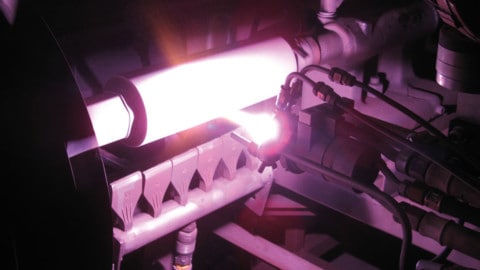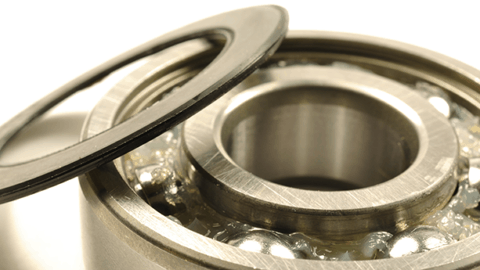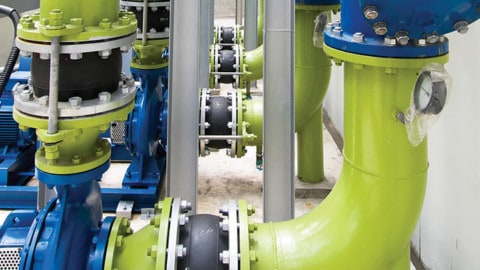Brown Brothers Engineers Australia Pty Ltd
A-K Glossary of pump terms here
L
Labyrinth seal: A non-contacting seal utilising a tortured path for the escape of the fluid. Utilises a series of pressure drops to reduce the leakage.
Lantern Ring: A device used to supply lubricant to packing. Usually located in the middle of the packing ring set.
Line bearings: These position the rotor or shaft radially and are normally of the sleeve type. Generally used in vertical pumps.
Liquefied Natural Gas LNG: This is liquefied gas from natural sources
Liquefied Petroleum Gas LPG: This is liquefied petroleum gas which is a by-product of the refining of crude petroleum oil.
M
Magnetic drive: A type of seal less pump that utilises permanent magnet technology to provide the rotation of the impeller.
Mating ring: Another name for the hard face in a mechanical seal. It can be either rotating or stationary.
Mechanical seal: A positive sealing device used to seal all fluids (liquids and gases). The primary seal is a set of lapped seal faces that are installed perpendicular to the shaft.
Metal bellows: Used in mechanical seal designs to eliminate the need for a dynamic elastomer and springs.
Metal fatigue: A breakage of the metal caused by the bending and flexing of a metal part beyond its endurance limit.
Minimum flow: The minimum capacity of a pump to prevent thermal and/or mechanical damage.
Moment of inertia: This represents a magnitude of the inertia in respect of the rotation around the axis of the pump and drive rotor.
Multistage Pump: This defines a pump that has more than one impeller on the shaft.
N
Negative pressure: A pressure below atmospheric pressure.
Newtonian Fluid: A Newtonian liquid is one whose viscosity does not change with increasing shear rate e.g. when agitated.
Non Overloading Power: This refers to the maximum power absorbed by a pump with a specific impeller diameter and liquid. Motors are generally sized at the next size above this power.
N.P.S.H.A: The net positive suction head available to prevent cavitation of the pump. It refers to the suction side of a pump installation and is defined as the head acting on top of the liquid + static head -vapor pressure head – friction head loss in the suction piping.
N.P.S.H.R.: Net positive suction head required to prevent cavitation of a pump and is dependent on impeller and pump design. The pump manufacturer determines the NPSHR by testing. In all cases, it is imperative that NPSHA >NPSHR to prevent cavitation
O
O.D.: Outside diameter.
Operating length: This measurement is set by manufacturers to provide the correct closing pressure on the two mechanical seal faces. The measurement can be made in a number of ways dependent on manufacturer. One measurement is from the face of the stationary face to the location screws for the rotating part of the seal.
Orifice Plate: A plate with a hole smaller than the pipe diameter in which it is located
Over hung impeller: Not supported with bearings on either side of the impeller.
P
Packing: The soft rings that a mechanical seal replaces to stop leakage. Packing must have a small leak because it works on the theory of a series of pressure drops to reduce the stuffing box pressure to the point where the leakage is acceptable. Generally, a minimum of five rings of packing is required to do this.
Parallel operation: This refers to two or more pumps that are discharging to a common header. It is important that the impeller speed and outside diameters are the same or one of the pumps may cause other pumps to operate at shut off.
pH: A measure of the acidity or the alkalinity of a fluid. The scale ranges from 0 (acid) to 14 (alkali) with 7 considered neutral.
Pipe strain: The strain on the pump volute caused by the piping. It will cause excessive mechanical seal movement and can cause contact between rotating and stationary pump and seal components. It can also cause serious misalignment with resultant damage to bearings and couplings.
Pitting: Surface voids caused by corrosion, erosion or cavitation. It is possible for the three to occur at the same time.
Positive Displacement Pumps: This is a collective definition of all pumps that operate according to the positive displacement principle. That is, the liquid being pumped is displaced by a body which periodically increases and decreases the working volume.
Power end: The end of the pump that attaches to the power source and is not wetted by the liquid. The bearings are in this part.
Precision bearing: Ball or roller bearing as opposed to a sleeve bearing.
Pressure gradient: The pressure drop between the seal faces.
Priming: This refers to the filling of a pump with liquid prior to operation.
Q
Quench: The introduction of a fluid outside the seal to cool the product, dilute any leakage across the seal faces or isolate seal faces from atmosphere.
R
Radial Bearing: This bearing handles most of the radial loads put on the impeller. In an end-suction centrifugal pump it is the bearing located closest to the stuffing box.
Radial Thrust: This is the thrust produced in the radial direction i.e. at 90 degrees to the centerline of the shaft, by forces acting on the impeller when operating at points other than BEP.
Radially Split Casing: A pump casing with the casing joint at 90 degrees to the shaft axis.
Rated Operation: This is the basis of selection of both pump and driver. When rated operation is specified, it generally exceeds the requirement of the design operation.
Ring Section Pumps: These are multistage pumps with several identical stage casings arranged in tandem behind each other. The stage casings are radially split.
Rockwell “C”: The scale used to define hardness of materials.
Run out: Twice the distance that the centre of the shaft is displaced from the axis of rotation.
S
Saturation Pressure: Same as vapour pressure.
Seal faces: The lapped faces that provide the primary seal in a mechanical seal.
Self Priming Pump: These pumps are capable of pumping liquids on a suction lift by being able to remove air from the suction line of its own accord. Most self-priming pumps need to be filled with liquid (primed) before the initial start, however their design means that subsequent starts do not require priming. Pumps that can self-prime from dry are limited to diaphragm and peristaltic type pumps only (both are positive displacement pumps).
Series operation: Two or more pumps connected with the discharge of the first pump discharging to the suction of the other etc. Rarely used these days.
Shaft packing: The soft packing located in the stuffing box to provide a shaft seal for pumps.
Shaft Power: The mechanical power absorbed at the pump shaft.
Shut off head: This is the maximum head that the pump can generate with a given impeller outside diameter. It is normally at zero capacity.
Sleeve bearing: A non-precision or anti-friction bearing. It is usually manufactured from carbon, teflon, brass, white metal, other synthetic bearing materials.
Slurry: A slurry is a liquid in which solids are present in suspension.
Solubility: This defines the ability of a liquid to dissolve with another liquid. For example, ethanol will fully dissolve in water whereas oil will float on water.
Specific Gravity (SG): This is the ratio of the mass of a liquid for a known volume to the weight of water for the same volume. The reference is water at 4 degrees C with an SG of 1.0. If the liquid you are questioning will float on water the specific gravity is less than one. If it sinks, it is higher than one. Note that this is based on the liquid not being soluble in water.
Specific Speed: Specific speed of a pump is determined by the geometry of a pump impeller. The higher the specific speed the less N.P.S.H. required.
Stainless steel: Alloy steels containing a high percentage of chromium and/or nickel.
Static head: The height of a liquid above a reference point e.g. pump centerline.
Stationary face: The seal face that does not rotate with the shaft.
Stuffing box: The portion of the pump that held the packing and now holds the mechanical seal.
Stuffing box pressure: The pressure in the stuffing box and generally between suction and discharge pressure but closer to suction pressure.
Submersible pump: A pump/motor pumpset that operates only when totally submersed in the fluid which is being pumped.
Suction lift: Pumping application where the liquid level on the suction side of the pump is below the pump centerline.
System resistance Curve: A graphed representation of how total dynamic head varies with capacity. A pump will operate where the system resistance curve intersects the pump performance curve.
System head: The head caused by friction in the piping valves and fittings.
T
Tandem seals: The seals are facing in the same direction with a low-pressure barrier fluid circulating between them.
Thermal conductivity: A measure of the material’s ability to conduct heat. This is a very important factor in the selection of mechanical seal faces.
Thixotropic fluid: The viscosity of the fluid decreases with agitation. Non-drip paint is an example of such a fluid.
Throttling: This means closing of a valve on the discharge side of a pump to increase friction loss. This steepens the system resistance curve with a resultant decrease in flowrate. Opening the valve results in an increase in flowrate.
Thrust bearing: This locates the rotor or shaft axially and is designed to handle any excess axial thrust load. In an end-suction pump, it is normally located close to the coupling.
Thrust: In a centrifugal pump it refers to the axial movement of the shaft. The thrust can be towards the wet or power end of the pump and at start up it thrusts in both directions.
Total Discharge Head: This is equal to the pressure at the pump discharge connection converted to head of liquid.
Total Dynamic Head: Total dynamic head is equal to total discharge head minus total suction head
Total Suction Head: This is equal to the pressure at the pump suction connection converted to head of liquid.
Tungsten carbide: A common hard face seal material available in several grades depending upon hardness and corrosion resistance. Cobalt and nickel are the two most common types.
Turbulence: This refers to disturbance of fluid as it enters the suction connection and /or the impeller. This can cause cavitation problems in a centrifugal pump. This is often caused by an insufficient length of straight pipe before the pump suction inlet.
U
Unbalanced seal: A mechanical seal not designed to balance the closing force between seals. Refer to Balanced Seal.
V
Variable speed motor: This is used to control flow in a system by varying the frequency of the motor. A better system than throttling as it reduces power consumption significantly.
Vacuum: This is a pressure less than atmospheric.
Vapor pressure: Below this pressure, the liquid at this temperature will vaporise.
Vaporisation: The fluid passes from a liquid to a gaseous state. If this happens at the seal faces the seal faces will be blown open.
Velocity: A measurement of the speed of the liquid in the system. This is measured in metres per second.
Velocity head: This is part of the total head calculation. This is calculated from the formula H = v2/2g.
Vent: This removes air or gas from the system. It is important to vent the stuffing box in vertical pumps to prevent the seal faces from running dry.
Viscosity: This is defined as the property of a liquid that offers resistance due to the existence of internal friction between layers within the liquid.
Viton®: An E.I. Dupont Dow manufactured fluorocarbon elastomer widely used in the sealing industry. Refer to Fluorocarbon.
Volute casing: This derives its name from a spiral-shaped casing surrounding the pump impeller. It converts velocity energy to pressure energy.
Vortex Pump: A type of pump used to handle liquids with entrained solids, particularly stringy solids. The impeller is recessed into the volute. A very low efficiency design, but practical in many applications.
Vortexing liquid: Creating a “whirlpool affect” that can draw air into the suction of the pump. Vortecies can form both from the surface of the liquid and in vertical pumps, from the floor of a pit or channel in which they are located.
W
Water hammer: This occurs in a closed piping system as a result of the pressure being rapidly increased when the liquid velocity is suddenly changed. This damaging effect is usually the result of sudden starting, stopping, change in pump speed, or the sudden opening or closing of a valve. Water hammer can usually be controlled by regulating the valve closure time, surge chambers, relief valves or other means.
Water Power: The calculated power coming on water at an efficiency of 100{87a03eb4327cd2ba79570dbcca4066c6d479b8f7279bafdb318e7183d82771cf}.
Watt: A measure of power.
Wear ring: This is used with closed impeller pumps to seal leakage from the high-pressure side of the pump to the low-pressure side. This may need to be replaced as it wears when the recommended clearance is doubled or when reduction in pump performance can no longer be tolerated.
Welded metal bellows: A seal design used to eliminate the use of elastomers. Excellent for cryogenic and hot applications. Not as effective for hot petroleum applications because of “coking” problems.
Wet end: The part of the pump that gets wet from the pumping fluid. Includes the volute, stuffing box, impeller wear rings, and shaft or sleeve.














